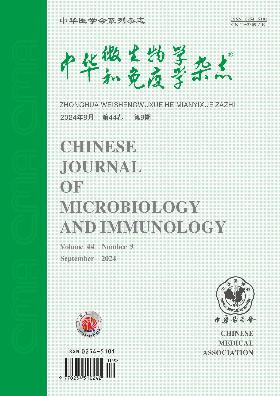Safety of yellow fever vaccine strain (Tiantan strain) in China and WHO vaccine strain 17D-213
Q4 Immunology and Microbiology
引用次数: 0
Abstract
Objective To study the intracerebral pathogenicity of the yellow fever vaccine strains of Tiantan strain used in China and WHO vaccine strain 17D-213 in mice. Methods Mice of different ages and strains were intracerebrally injected with same amount of Tiantan strain and 17D-213 strain. The death and survival of mice were observed and recorded. The LD50/ml and half survival time of the two vaccine strains were compared and analyzed. Results There was no difference in LD50/ml between the Tiantan strain and 17D-213 strain when used through intracerebral injection in one-day-old suckling mice, 7-9 g mice or 12-14 g mice. Moreover, no significant difference in survival trend was found in 7-9 g mice or 12-14 g mice injected with the two vaccine strains. However, the two strains had statistically different influences on the survival trend of one-day-old suckling mice. The half survival time of the Tiantan strain was 11 d, while that of the WHO vaccine strain 17D-213 was 6 d. Excepting in NIH mice, no significant differences in LD50/ml were detected between the same amount of two strains in BALB/c, KM, ICR or C57 mice. Conclusions The yellow fever Tiantan vaccine strain and WHO vaccine strain 17D-213 have no significant difference in the intracerebral pathogenicity in mice of different ages and strains with good safety. Key words: Yellow fever; Vaccine strain; Intracerebral pathogenicity; Safety中国黄热病疫苗株(天坛株)与世界卫生组织疫苗株17D-213的安全性
目的研究中国天坛黄热病疫苗株和世界卫生组织疫苗株17D-213在小鼠脑内的致病性。方法对不同年龄、不同品系的小鼠进行脑内注射相同量的天坛品系和17D-213品系。观察并记录小鼠的死亡和存活情况。对两株疫苗的LD50/ml和半数存活时间进行了比较分析。结果天坛品系与17D-213品系在1日龄乳鼠、7-9g小鼠和12-14g小鼠脑内注射时LD50/ml无差异。此外,在注射了两种疫苗株的7-9g小鼠或12-14g小鼠中,未发现存活趋势的显著差异。然而,这两种菌株对一日龄乳鼠的存活趋势有统计学上的不同影响。天坛株的半数存活时间为11d,而世界卫生组织疫苗17D-213株的半数生存时间为6d。除NIH小鼠外,在BALB/c、KM、ICR或C57小鼠中,相同量的两种株的LD50/ml没有检测到显著差异。结论黄热病天坛疫苗株与世界卫生组织疫苗株17D-213在不同年龄、不同株系小鼠脑内致病性无显著差异,安全性较好。关键词:黄热病;疫苗株;脑内致病性;安全
本文章由计算机程序翻译,如有差异,请以英文原文为准。
求助全文
约1分钟内获得全文
求助全文
来源期刊

中华微生物学和免疫学杂志
Immunology and Microbiology-Virology
CiteScore
0.50
自引率
0.00%
发文量
6906
期刊介绍:
Chinese Journal of Microbiology and Immunology established in 1981. It is one of the series of journal sponsored by Chinese Medical Association. The aim of this journal is to spread and exchange the scientific achievements and practical experience in order to promote the development of medical microbiology and immunology. Its main contents comprise academic thesis, brief reports, reviews, summaries, news of meetings, book reviews and trends of home and abroad in this field. The distinguishing feature of the journal is to give the priority to the reports on the research of basic theory, and take account of the reports on clinical and practical skills.
 求助内容:
求助内容: 应助结果提醒方式:
应助结果提醒方式:


